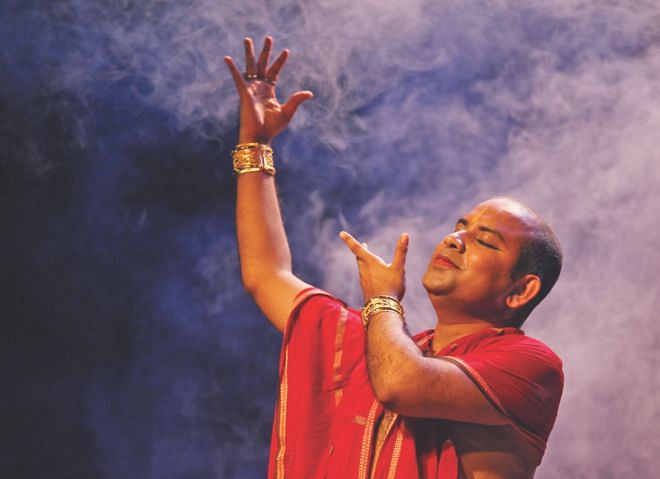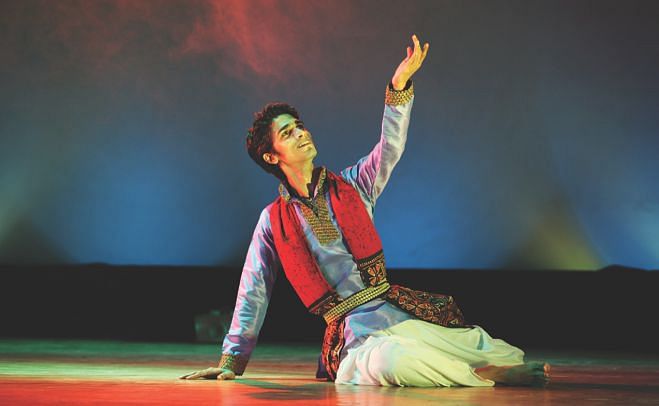Dancing for the Soul

And you walk to the centre stage with your ghungur tightly attached to your ankles, chiming with every step you take and the first drop of sweat trickles down your face. You look beautiful and presentable with the layers of makeup. You take your opening position and try to find some familiar pairs of eyes. But everything in front of you is dark and you are oblivious to the audience and their reaction. You feel so light that you might just float away like a leaf but then you are weighed down by so much jewelry and costume. A yellow spotlight falls on you like the ones in interrogation rooms and artificial smoke is let out. But the music finally reaches your ears and you feel tranquil again. You are a performer, an artist, a dancer and you are divine.
Ever wondered why people still dance classical? What's so fascinating about it, that even after the excruciating amount of effort and practice and pain, performers say that it's totally worth it? I spoke to two brilliant dancers to find out about the magic behind classical dancing.
So many learn dancing as exercise, a kind of fulfillment of their parent's dreams, just another extracurricular activity, or simply as entertainment. But isn't there more to dancing? Young aspiring classical and contemporary dancer/choreographer, Amit Chowdhury, agrees. To him, dancing is suffixed to oxygen – meaning, there is no way he can live without it. On stage doing solos, he feels like he is his own competitor, always striving to do better than himself. He says competitors and criticism are important tools for dancing. Being a male dancer and having to perform with twice the mental strength than females in our community, he says he is proud to shout out loud that he is a dancer by profession.

Highly established classical dancer from West Bengal, Rajdeep Banerjee, says, without hesitation, that classical dance is divinity and life. When asked what a person can get out of dancing, he said “We dance for ourselves and our souls. By dancing, we express and understand ourselves. It gives a positive aura around us. So we should dance, to entertain ourselves and our minds.” On stage, he goes into a trance of spirituality. The stage isn't just a stage. It is a platform via which we can connect to God. And the way to connect is by practice – Shadhana. The music should be heard and taken into the soul, from the soul we feel it properly and concentrate. “We dancers take the audience from their ordinary daily life of everyday things to a whole new world,” says Rajdeep.
In our conservative community, how would we bring about the popularity of dancing, when people think that it is taboo for girls to dance and when male dancers are looked down upon, as if they aren't like other men? In Amit's opinion, dancing is actually a sacred action and the reality shows being produced in our country in the name of 'dancing' are totally wrong. When dancing is even capable of changing someone's life absolutely, why should it be misjudged that way? Rajdeep believes that dancers themselves play a great role in being thought of in such a way. Is dance only an entertainment and dancers only entertainers? Surely it can be a form of entertainment, but isn't it also education? If dancers think of themselves just as entertainers, people will eventually take them for granted and misuse them. But if it can be understood that dancing is also educational, wouldn't it result to something positive? About male dancers, he thinks that they struggle more than females as they have to fight against their community, their friends and family and then have to become economically established. They indeed travel a great way for their passion.
Classical dance has rules and books. They're like the A-B-C of any form of dancing. For any child to create sentences, he must know his alphabets. So to pursue other forms of dancing, wouldn't it be helpful to have a classical background? In Rajdeep's words -- “Classical Asian dancers have the ability to take their audience to a different mood – Maksha. The viewer and the dancer get a feeling of absolute tranquility, of positive energy. And here, the feelings count the most.”
The writer is a young, aspiring dancer.

 For all latest news, follow The Daily Star's Google News channel.
For all latest news, follow The Daily Star's Google News channel. 



Comments